Wang Tiande 王天德
Reading the Stele in Light Snow 薄雪读碑图, 2019
Ink, calligraphy and burn marks on xuan paper 宣纸、墨、火焰、书法
166 x 49.5 cm, 166 x 80 cm x 4
Further images
-
(View a larger image of thumbnail 1
)
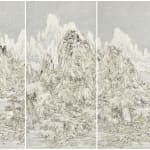
-
(View a larger image of thumbnail 2
)
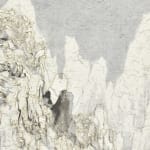
-
(View a larger image of thumbnail 3
)
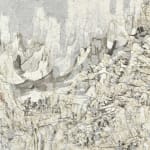
-
(View a larger image of thumbnail 4
)
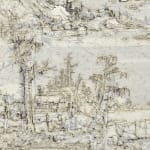
-
(View a larger image of thumbnail 5
)
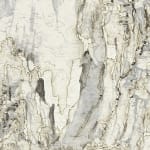
-
(View a larger image of thumbnail 6
)
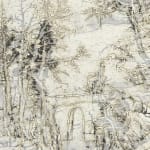
-
(View a larger image of thumbnail 7
)
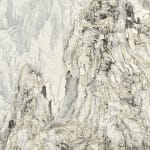
-
(View a larger image of thumbnail 8
)
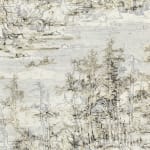
-
(View a larger image of thumbnail 9
)
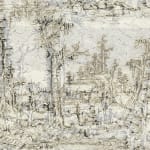
-
(View a larger image of thumbnail 10
)
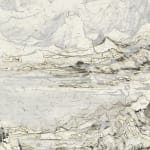
-
(View a larger image of thumbnail 11
)
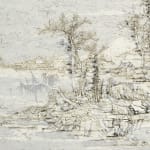
-
(View a larger image of thumbnail 12
)
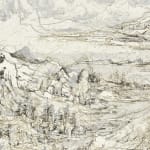
-
(View a larger image of thumbnail 13
)
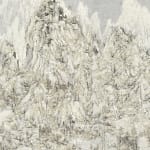
-
(View a larger image of thumbnail 14
)
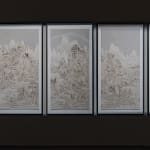
-
(View a larger image of thumbnail 15
)
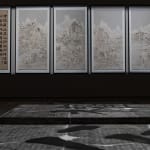
-
(View a larger image of thumbnail 16
)
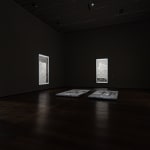
Reading the Stele in Light Snow, 2019, is a monumental composition that perhaps best exemplifies Wang Tiande’s mastery of the art historic discourse. The subject of the winter landscape reaches...
Reading the Stele in Light Snow, 2019, is a monumental composition that perhaps best exemplifies Wang Tiande’s mastery of the art historic discourse. The subject of the winter landscape reaches back to Wang Wei of the Tang yet the theme of reading stele’s dates to the early Qing, particularly the kaozhengxue scholar Zheng Fu. Wang Tiande’s dynamic mountain forms evoke Wang Yuanqi, whose own Wangchuan Villa handscroll itself invokes the looming presence of Wang Wei. Unlike Wang Yuanqi, however, Wang Tiande situates his dynamic forms within a coherent, resonant space evocative of the Northern Song monumental landscape. Indeed, taking each panel as an individual, vertical composition, we see echos of Li Cheng’s wintry Northern landscapes. As as a four panel horizontal river landscape, however, Wang Tiande himself cites Huang Gongwang as his source of inspiration.
Perhaps most extraordinary, however, is that we recognize this work immediately as a Wang Tiande. His signature use of burning and layering paper, where he literally burns away his own brushwork leaving only an empty void within a material paper lattice of liubai or kongbai, creates a visual language that—not unlike that of Huang Binhong, Wang Yuanqi or Dong Qichang—is completely unique and immediately identifiable as his own. Perhaps more extraordinary is that Wang Tiande's language takes away or obfuscates—through burning, layering and covering—the one criterion—namely bimo—that unifies the artistic tradition that he has chosen to revive. What are we to think of a literati painter who burns away his own brushwork? In Wang Tiande, we discover a paradox: an avant-garde, conceptual artist in the lineage of Duchamp and Cage, performing brilliantly as a arch-traditionalist.
Perhaps most extraordinary, however, is that we recognize this work immediately as a Wang Tiande. His signature use of burning and layering paper, where he literally burns away his own brushwork leaving only an empty void within a material paper lattice of liubai or kongbai, creates a visual language that—not unlike that of Huang Binhong, Wang Yuanqi or Dong Qichang—is completely unique and immediately identifiable as his own. Perhaps more extraordinary is that Wang Tiande's language takes away or obfuscates—through burning, layering and covering—the one criterion—namely bimo—that unifies the artistic tradition that he has chosen to revive. What are we to think of a literati painter who burns away his own brushwork? In Wang Tiande, we discover a paradox: an avant-garde, conceptual artist in the lineage of Duchamp and Cage, performing brilliantly as a arch-traditionalist.
1
of
12
















